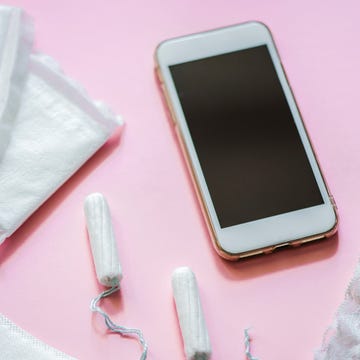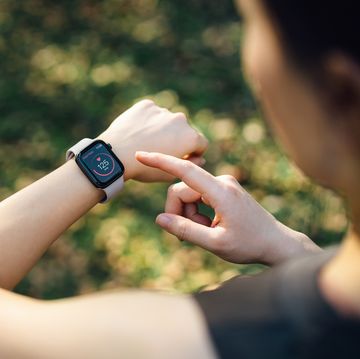Reproductive rights faced a big blow on Friday after the Supreme Court of the United States overturned its landmark 1973 court case, Roe v. Wade, which protecting a person's right to an abortion in this country. The news left people scrambling for more information and considering what options they have to protect themselves from an unwanted pregnancy.
Some people may even be considering more long-term preventative methods, like an Intrauterine Device, or IUD, which is a reversible, long-lasting, and highly effective form of contraception that can offer years of pregnancy protection.
But when it comes to birth control, it can feel like there are endless choices. Within the IUD category itself, there are so many options. Deciding which method is right for you, weighing efficiency rates, side effects, hormone levels, and lifespan, becomes the longwinded personality test of contraception.
More From Women's Health

“IUDs work by interfering with the ability of the sperm and the egg to get together,” says Gil Weiss, MD, an ob-gyn at The Association for Women’s Health Care in Chicago and Associate Professor at Northwestern Memorial Hospital. “And each of these IUDs do it in a different manner.”
The good news is all types of IUDs are comparable in success rates. No one is thought to be better or safer than another, so you can't really go wrong if you've made up your mind about using IUDs. The choice is a matter of personal preference.
Globally, about 14.3 percent of reproductive-aged people use IUDs. Dr. Weiss compliments the IUD for its low maintenance, as well as success rate. “The IUD is in you, and it’s not dependent on human behavior,” he says, “You get the IUD placed by your physician and you know it’s in there doing its job.”
Plus, “it’s very reasonably priced in the long run. Over several years, it becomes more economical than birth control pills,” he adds.
Meet the experts: Dr. Gil Weiss, MD, ob-gyn is a partner at the Association for Women’s Health Care in Chicago and is an assistant professor at Northwestern Memorial Hospital.
Dr. Sherry Ross, MD, ob-gyn is the author of She-ology: The Definitive Guide to Women’s Intimate Health. Period.
What are IUDs?
Intrauterine devices (IUDs) are a type of birth control that are inserted through the cervix into your uterus. There are small strings on the end that protrude through the cervix into your vagina, letting you know that the IUD is still in place.
They are a form of reversible contraceptives that can last anywhere between three and 12 years. However, the pregnancy prevention device can be removed at any point to restore fertility.
It is more than 99 percent effective, making it one of the most successful birth control methods available. Less than one out of every 100 women will get pregnant while having an IUD, according to Planned Parenthood.
A large part of this method’s success is its mindless, constant nature. You don’t have to remember to take it, like you do with the pill, which is only 91 percent effective, or use it correctly, similarly to condoms, which rank lower with an 85 percent efficiency rate, per Planned Parenthood. The IUD works on its own, regardless of whether or not you pay it much mind.
Basically, they are the best of both worlds: highly effective birth control you barely have to think about, said Sherry Ross, MD, an ob-gyn and the author of She-Ology: The Definitive Guide To Women's Intimate Health. Period. (Sigh of relief, anyone?)
What is the difference between a hormonal and copper IUD?
There are two categories of IUDs: hormonal and nonhormonal. The one that’s best for you depends on personal factors such as period regularity and cramping, your body’s response to hormones, and your desired length of contraception.
The nonhormonal one, also known as a copper IUD, has a small copper wire wrapped around the device. It has no hormones and can last up to 12 years. The copper IUD “makes the environment hostile for the egg and the sperm to get together,” says Dr. Weiss.
Among being a highly effective daily birth control option, it is also the most effective emergency contraceptive currently available if inserted within five days of unprotected intercourse. Once inserted, you have protection lasting for years, versus Plan B or other oral emergency contraceptives, which are only good for one use.
The second class of IUDs release a hormone called progesterone. Depending on the specific hormonal IUD, the pregnancy prevention method may be different. In one scenario, certain hormonal IUDs “tend to make the mucus thicker, which makes it more difficult for the egg and the sperm to unite,” Dr. Weiss said.
Another way hormonal IUDs work is by preventing ovulation, which lessens or entirely gets rid of some women’s periods, says Dr. Weiss.
Are there any downsides to getting IUDs?
And between the consultation, the procedure, and the adjustment period, “IUDs require a little bit more of a commitment,” says Dr. Weiss. And, in the worst-case scenario, if you don’t like your IUD, it requires another doctor’s appointment to get it removed.
For some women, especially those who've had children, it's a minor annoyance; for others, it can be extremely painful, particularly if the doctor needs dilators to open up your cervix more. Unfortunately, there is no way to know which end you will be on.
The good news is that the worst of it is over in a few minutes and the whole appointment shouldn't take more than a half hour, says Dr. Ross. The bad news: While everyone's different, there's a chance that you could experience cramping or spotting for three to six months after insertion, according to Planned Parenthood. Removing it, thankfully, is usually pretty simple and pain-free, requiring a short doctor's visit, she added.
Dr. Weiss recommends his patients to take an ibuprofen two hours before coming in to help minimize the pain. He also recommends having realistic expectations about the procedure, claiming that “knowing what’s going on is pretty important.” There is also the option of numbing the area down there with a local anesthetic to make the insertion process more comfortable.
It’s also important to note that while IUDs are an extremely effective form of contraception, they do not protect you from STDs.
Now that you’ve got the facts down, it’s time to make the selection of which IUD is actually right for you. Keep reading for the five different paths to long lasting, low maintenance protection.
1. Paragard
How it works: Paragard is the only brand of nonhormonal IUD in the U.S. It's wrapped in thin copper, which causes an inflammatory response in your body. This helps prevent sperm from getting through your cervix, and any little swimmers that do make it up there are neutralized by the copper ions, which are toxic to sperm.
Side effects: The inflammation caused by the copper blocks sperm, yes, but can also increase menstrual bleeding, both the duration and the flow, says Dr. Ross. Other side effects include anemia, increased cramps, and random spotting, she adds.
It may make your periods a touch crampy or heavy in the beginning, but in the long term, it works very, very well and doesn’t make your period cramps heavier, says Dr. Weiss.
You may have heard that your friend’s IUD made her gain weight or break out or even lose her hair. There is no evidence that a copper IUD causes weight gain, says Dr. Weiss.
How long it lasts: The device lasts for 12 years, according to Dr. Weiss.
Who it's best for: Women who want to avoid synthetic hormones for any reason, have a normal to light flow, and want the longest-lasting option.
Who should avoid it: If your cramps and bleeding are already bad, then a nonhormonal IUD probably isn't for you, says Dr. Ross.
2. Mirena
How it works: Mirena releases 20 micrograms of levonorgestrel, a synthetic form of progesterone, per day. This type of IUD has the highest progesterone dosage, Dr. Weiss notes. This hormone thickens your vaginal mucous, thins out your uterine lining, and can prevent your ovaries from releasing an egg, all of which prevent any rogue sperm from latching onto an egg and fertilizing it.
Side effects: Because it thins out your uterine lining, the most common side effect is having a significantly lighter period or no period at all, says Dr. Ross. Other issues may include nausea, breakthrough bleeding, ovarian cysts, and mood changes.
And the production of progesterone hormones is not as good for your skin. It doesn’t mean that it’ll make it worse, but it may not necessarily make it better. Only 1o percent of women with hormonal IUDs experience this side effect, Dr. Weiss says. Hair loss is occasionally caused by the effect progesterone has on a person’s hormone levels after a couple of months.
How long it lasts: Seven years, according to Mirena's website.
Who it's best for: Women with super-heavy periods.
Who should avoid it: If you are prone to ovarian cysts or react badly to progestin, take a pass, says Dr. Ross, as Mirena could up your risk of those. If you're hesitant about not having a period at all, skip this one too.
3. Liletta
How it works: Liletta works exactly like the Mirena, except it uses slightly less levonorgestrel, releasing 19.5 micrograms per day—and that amount decreases a little each year after (that doesn't hinder its effectiveness, though). Liletta has the second highest progesterone dosage.
Side effects: Just like with Mirena, you may experience nausea, ovarian cysts, breakthrough bleeding, and mood changes. Many women also experience a lighter period or have no period at all.
How long it lasts: Six years, according to the Liletta website.
Who it's best for: Women without health insurance or whose insurance doesn't cover IUDs.
Who should avoid it: Women who react badly to synthetic progesterone or are prone to ovarian cysts should steer clear.
4. Kyleena
How it works: Kyleena works just like Mirena and Liletta, but contains slightly less of the hormone levonorgestrel, releasing 17.5 micrograms a day—the second lowest dose you can find in a hormonal IUD.
Side effects: Again, this is similar to Mirena and Liletta, meaning side effects include nausea, ovarian cysts, breakthrough bleeding, and mood changes. It can also lessen or stop your period, but the effect isn't as pronounced due to the smaller dosage.
How long it lasts: Five years, according to Kyleena's website.
Who it's best for: Women who still want ample protection, but also want to get their period regularly. Kyleena is also best for women who have occasional breakouts and, therefore, may want less of the hormone while still prioritizing long-term contraception, notes Dr Weiss.
Who should avoid it: Women who react badly to synthetic hormones.
5. Skyla
How it works: “Skyla is the smallest IUD with the smallest duration of contraceptive use,” explains Dr. Weiss. It works similarly to the previously mentioned IUDs, but contains the smallest amount of levonorgestrel, releasing just 14 micrograms a day.
Because of its smaller size, it may be easier to insert, particularly in women whose cervix is tighter, says Dr. Ross. (Worth noting: The size difference is pretty minimal.)
Side effects: The same as all the hormonal IUDs: cysts, nausea, mood swings, lighter bleeding. But because the dosage is lower, many women find the side effects to be less bothersome than IUDs with higher doses.
How long it lasts: Three years, per Skyla's website.
Who it's best for: Women who haven't had children or have a tight cervix, or those who want to keep getting periods while they're protected.
Who should avoid it: Women who would like protection for more than three years.
The bottom line: IUDs are an effective form of birth control. While there are some variations in type and hormone dosage, the choice ultimately comes down to what you feel most comfortable with. You really can't go wrong with any one of them!
Charlotte Hilton Andersen has been a health and fitness writer for 12 years and is the author of The Great Fitness Experiment. Her three great loves are her family, jelly beans, and true crime podcasts on the treadmill (but only the ones against the wall so no one can creep up on her).












